Launch of the Kaitakushi Beer Brewery and sale of Sapporo Beer
The Meiji government established a new administrative unit in Hokkaido in July 1869 in order to open up the region and annex it. Until the Kaitakushi brand was closed down in 1882, the business grew into over 30 breweries. That wide portfolio of businesses included beer brewing.
The administrative government brought into its ranks Seibe Nakagawa, a Japanese beer brewer who had trained in the art in Germany. Construction of the brewery began in June of 1876, and the Kaitakushi Beer Brewery was completed in September. This marked the start of Sapporo Beer. The brewery was a two-story wooden building with 860 square meters of floor space. This is a commemorative photograph taken when it opened for business. The piles of beer barrels are inked in white text that reads: “Ceremony: combining barley and hops yields a spirit called ‘beer’.” This beer was cold-brewed and referred to as Sapporo Beer, going on sale in September of 1877 in Tokyo. Cold brewing is a German technique for fermenting and aging beer at low temperature. Featured on the label is the Kaitakushi logo, the North Star, which is a traditional symbol of Sapporo Beer.
Kuroda, director of the new Hokkaido administrative government, ordered use of locally-grown barley and hops for the production of beer. This was the start of Sapporo Beer’s selective breeding and collaborative agreements with farms, something that remains alive and well today.
The administrative government experimented with cultivation of barley at test farms, but they struggled to find a strain suited to the climate. In 1880, they were finally able to produce a large volume entirely within Hokkaido. However, for several years, the hops seedlings planted would dry out and die. It was only in 1881 that all of the hops needed for use by the Kaitakushi Beer Brewery could be sourced entirely locally.
In March 1882, when the administrative government was abolished, Kaitakushi Beer Brewery fell under the jurisdiction of the Ministry of Agriculture and Commerce and was renamed to Sapporo Beer Brewery. Then, in January of 1886, the brewery was moved to the new Hokkaido government office. Michitoshi Iwamura, the first director of the Hokkaido prefectural government office, sought to promote the infusion of capital from the mainland into Hokkaido, so he proposed a public sale and lease of prefectural plants and farms to the private sector.
Kihachiro Okura then bought the Sapporo Brewery, which the Hokkaido government had decided to sell off. In November of 1886, the government-managed beer business was privatized and launched anew under the name Okuragumi Sapporo Beer Brewing. Yet the following year, Okura transferred the business to Eiichi Shibuzawa and Soichiro Asano, who wielded considerable influence in political and business circles. Okura sought to make beer brewing a more established and remunerative business. In December of 1887, Okura himself joined the management and established the new Sapporo Beer Co., Ltd. With Shibuzawa joining the roster, the team had built a foundation for growth.
-
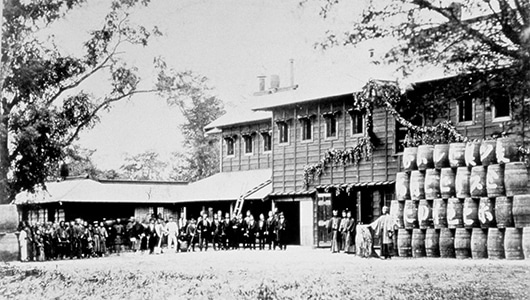
A commemorative photo taken at the opening ceremony for the Kaitakushi Beer Brewery -
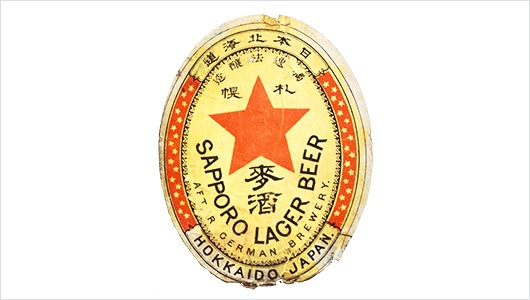
The Sapporo Beer label when it was first released
Establishment of the Nippon Beer Jozo Co., Ltd. and launch of Yebisu Beer
Small and mid-scale financiers in the Tokyo and Yokohama area who had taken an interest in the potential of beer established Nippon Beer Jozo Co., Ltd. in September of 1887. However, given that the roster of company founders did not include any financiers or entrepreneurs of major repute, they lacked the ability to raise major investment. Yet by April of 1889, the record of shareholders listed executives from Mitsui & Co., Ltd. Securing these stable investors allowed Nippon Beer Jozo to set itself on the path to stable operations.
In October 1889, two years after the company was founded, the Yebisu Beer brewery was built in what is now Mita, Meguro-ku, Tokyo. All of the beer brewing equipment was purchased from Germany, with brewing engineers also hired from the country. In December of the same year, beer brewing started. In February of 1890, Yebisu Beer went on sale.
This new Yebisu Beer became quite popular for its high quality. It was so popular, in fact, that counterfeit versions even appeared on the market. That being said, in those days, few people were familiar with beer, so it was still not a major player on the beverage market. Seeking to allow customers to enjoy draft beer shipped directly from the brewery and appreciate its quality for themselves, in August of 1899, the Yebisu Beer Hall opened at Ginza 8-chome in Tokyo as Japan’s first beer hall. The shop was just in 132 square meters in size, and featured an innovative decor that differed from traditional pubs. Customers heard news of the establishment and traveled far and wide to try it. Edoites, who had a penchant for all things new, loved it. On some days, they even briskly sold 1,000 liters of beer. Though intended as a form of PR, the shop was posting solid revenue and became a source of income in its own right.
Nippon Beer president Kyohei Makoshi was confident about the future of the beer industry and invested more capital in the venture to proactively drive management of the company forward. This was intended to spur innovation of the brewing equipment and incorporate the latest advances. It was an attempt to further increase the quality of Yebisu Beer. The beer went on to take the gold prize at the Paris Exposition in 1900. This accolade was drawn against a pool of beers from over thirty countries, so it was a testament to the quality. The beer also took the grand prize at the Louisiana Purchase Exposition in 1904. This meant that the product had not only drawn acclaim in Europe, but even the United States, and was gaining global renown.
In February of 1901, Nippon Beer, seeking to ship higher quantities of beer faster, launched the Yebisu Railyard as a dedicated freight station. As the population around the brewery grew, Nippon Railway opened a train station near Shibuya Station in October of 1906. That station is today’s JR Ebisu Station.
In January of 1928, the Date area and other environs in Shibuya were unified under the name Ebisu-dori (Ebisu Street). In this way, the product name turned into a train station name and then led to its being adopted for an entire area, something exceedingly rare.
-
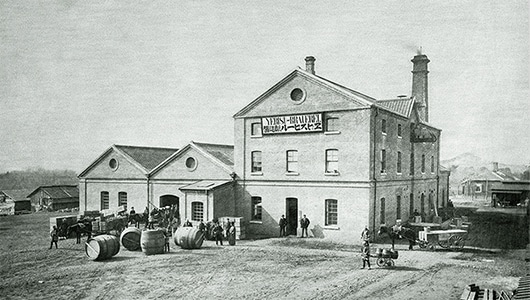
The Yebisu Beer Brewery when it was first completed -
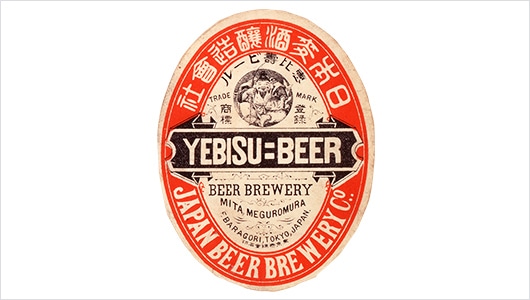
The Yebisu Beer label when it was first released -
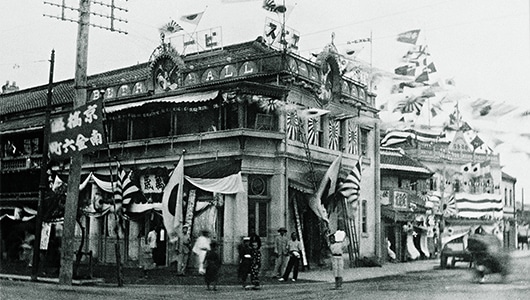
The exterior of the Yebisu Beer Hall -
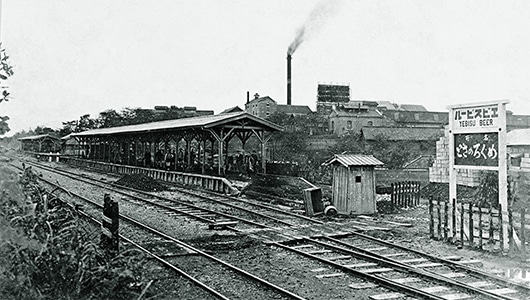
The Yebisu Railyard
A major merger leads to the launch of the Dainippon Beer Co., Ltd.
The beer industry in the late 1890s exhibited intense price wars between four major firms: Sapporo Beer (brewer of the eponymous Sapporo Beer), Nippon Beer (Yebisu Beer), Japan Brewery Company (Kirin Beer), and Osaka Beer (Asahi Beer).
Sapporo Beer, given its location in Sapporo, suffered a slight disadvantage in terms of location and access to the market. The company was being beaten out by a wide margin in the Keihin region by Yebisu Beer and Kirin Beer. In June of 1899, at an extraordinary meeting of shareholders, the company proposed building a Tokyo Brewery. The motion was approved. In September of 1903, the Tokyo Brewery was completed along the banks of the Sumida River, and Sapporo Beer began shipping its merchandise. The brewery exerted considerable influence in the area; two years later, in 1905, Sapporo Beer had become the industry leader by volume of beer brewed.
The most affected by this was Yebisu Beer, which had enjoyed major support in the Kanto region. Nippon Beer fell on catastrophic times as a result of this, and president Kyohei Makoshi debated with Sapporo Beer chairman Eiichi Shibuzawa and Osaka Beer president Komakichi Torii the possibility of forming an alliance. Makoshi’s proposal was accepted by Shibuzawa and Torii, and they agreed to amalgamate. In March of 1906, Sapporo, Nippon, and Osaka Beer formed into the Dainippon Beer Company, which now commanded seventy percent of the share of the market. Makoshi was appointed as president. Makoshi would later refer to Dainippon Beer as the “King of Eastern Beer,” growing it into the largest beer concern east of the Suez Canal.
-
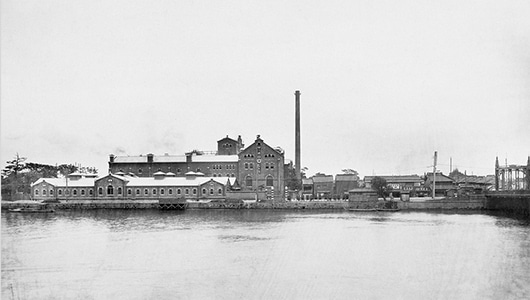
Sapporo Beer Tokyo brewery -
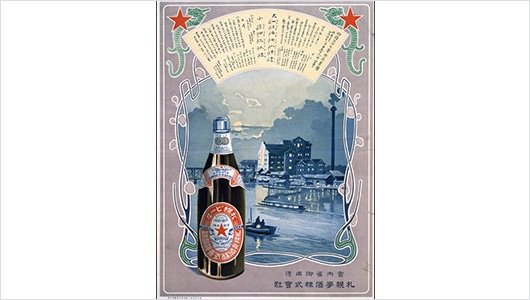
A 1904 poster for Sapporo Beer
From Nippon Beer to Sapporo Beer
Dainippon Beer was subject to the Act for Elimination of Excessive Concentration of Economic Power, and in September of 1949, it was split up into Nippon Beer and Asahi Beer. Nippon Beer inherited the Sapporo and Yebisu brands from Dainippon Beer, but given that these were both local brands, adopting them for the name of the new company would not have been a good fit. Given the nationwide scope of the business and its predecessor having been Dainippon Beer, the new company was thus named Nippon Beer.
In December of 1951, the original brands of each brewery were brought back on the market. Nippon Beer’s new brand was dubbed Nippon Beer. Consumers were not familiar with it and did not immediately take to it. While beer consumption was growing year over year, Nippon Beer alone struggled to gain acceptance. Though Sapporo Beer’s share of the market had been on a decline, around 1954, there started to emerge interest in seeing it back again. March of 1956 marked the 80th anniversary of the founding of the Sapporo plant, and a Hokkaido-exclusive Sapporo Beer went on sale in its native hometown. Sales were exceedingly brisk immediately after the product went on the market. It was so successful that they decided to roll out a nationwide release in January of the next year. In January of 1964, the company name was changed to Sapporo Beer Limited.
-
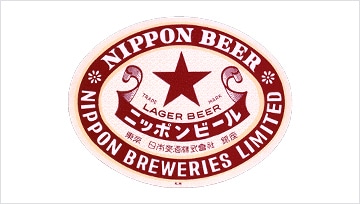
The Nippon Beer label -
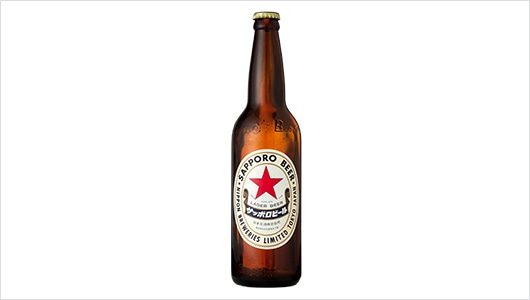
The new Sapporo Beer nationwide -
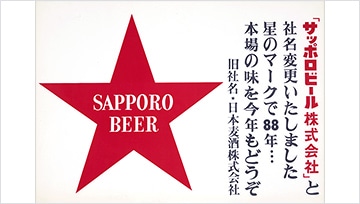
A newspaper advertisement announcing the new company name
Yebisu Beer is recreated and goes back on sale
Sapporo Beer, having changed its name, brought the Yebisu Beer brand, which had been a pre-war favorite, back on the market in December of 1971. During wartime in 1943, all beer brands had halted production. This marked the first time in 28 years that Yebisu was back on the market since that time. Rather than just bring the old brand back, the company decided to commoditize it in a varied lineup that included a high quality beer and a German-style beer. German-style beer refers to beer produced in compliance with the 1516 Reinheitsgebot laws. Only barley, hops, and water can be used. This makes German beer 100% malt-based and free of rice, corn, or other additives. The company’s braumeisters doubled down on production of beer that contained no other additives, succeeded in recreating a 100% barley beer for the first time in Japan after WWII. The long-term aging process produced a rich and deep Yebisu Beer that captured the interest of the public. The slogan was: “Specialty Yebisu Beer: a delicacy reborn.” This was the frontrunner in the new wave of premium beers.
-
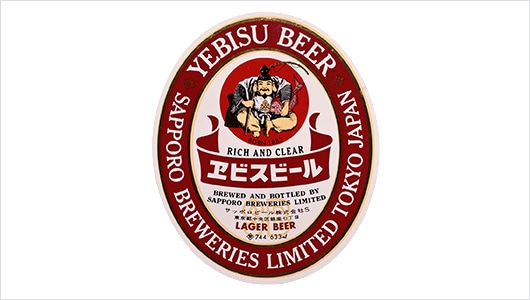
The classic Yebisu Beer label after being reintroduced -
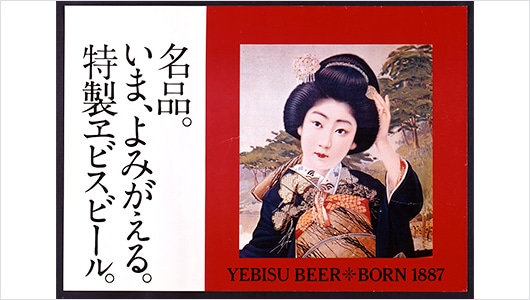
A Yebisu Beer poster from 1971
Kuro Label, a longtime bestseller
Sapporo’s cask draft beer had been well regarded at Sapporo Lion and other beer halls. Customers looked for Sapporo when it came to draft beer. The company resolved to commit to production of draft beer, which had a competitive advantage on the market. In April 1977, bottled Sapporo draft beer went on sale nationwide.
One issue with commercializing bottled draft beer was removing the yeast residue after fermentation. The company’s engineer team devised a unique ceramic filter, a sterilized filtration system that removes the yeast without affecting the flavor of the beer.
Yet Sapporo’s bottled draft beer faced another major issue.
Namely, the consumer tended to think of draft beer as a summer beverage. At the time, draft beer was largely seen as a summer drink and proved unpopular in winter. The sales team focused on promoting the product as something delicious year-round. This proved successful, and bottled draft beer became a sensation. It became so popular that people even talked about being of the “Bottled Draft Beer School” of thinking.
The black-colored label used in Sapporo Bottled Draft Beer led to it being affectionately called “Kuro Label” beer by patrons. This colloquial name was formally adopted as the brand name in 1989. In this way, Kuro Label was actually named by our customers. It remains an undying favorite to this very day.
-
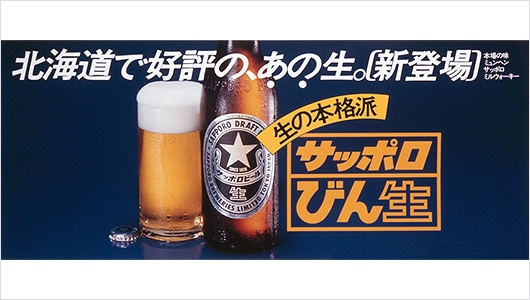
A poster for Sapporo Bottled Draft from 1977 -
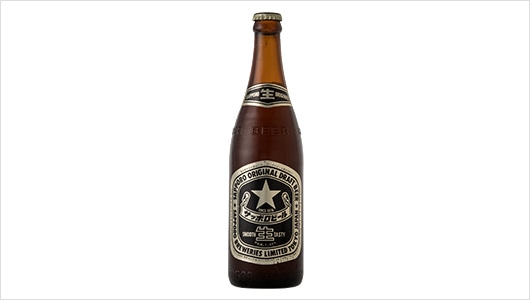
Sapporo Draft Kuro Label
Sapporo Beer’s advertising campaign
The use of trademarks had been prohibited during wartime, but in 1949, this ban was lifted. This allowed the beer industry to launch advertising wholesale. The history of Sapporo Beer’s post-war advertising begins in 1950 with an advertisement for Nippon Beer.
“The King of Beer” was released in 1954. An illustrated character by Takashi Yanase, who was a leading cartoonist at the time, was used for a series of advertisements. This was also used in conjunction with various events to gain publicity exposure. This created a much more unified approach to the company’s advertising, and it drew attention.
Sapporo Beer’s nationwide re-release allowed for the advertising campaign to really kick into gear by promoting the idea of the beer being authentic in flavor. This was particularly the case with the 1958 Munich Sapporo Milwaukee campaign. Free travel overseas was still not permitted, so the advertisement depicted the epicenters of authentic-style beer worldwide with a cutting-edge catchphrase that consumers found very convincing.
In 1970, global celebrity Toshiro Mifune appeared in our advertising. Posters were designed to be totally simplified, with no logos, main copy other than a slogan, and no labels. The TV commercials also eschewed narration and used only music. The bold tagline was “Men keep quiet and drink Sapporo Beer.” This campaign swayed the nation.
Thirty years later, in January of 2000, commercials for the new Sapporo Draft Kuro Label, a revamp of Sapporo Beer for a new era, were broadcast. The first installment, Ping Pong at the Hot Springs, was a smash hit. According to CM Databank, it had the most viewership across all industries.
-
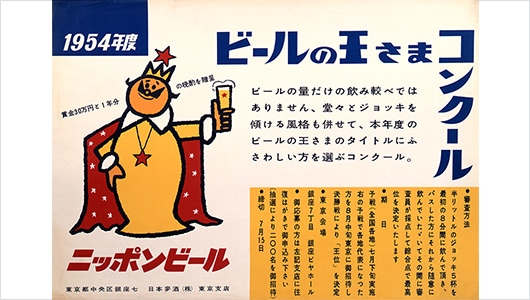
A 1954 poster for the King of Beers Contest -
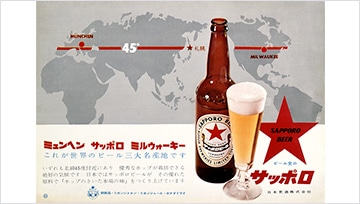
A 1958 poster for Munich Sapporo Milwaukee -
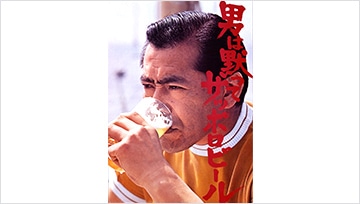
A 1970 poster for “Men keep quiet and drink Sapporo Beer.” -
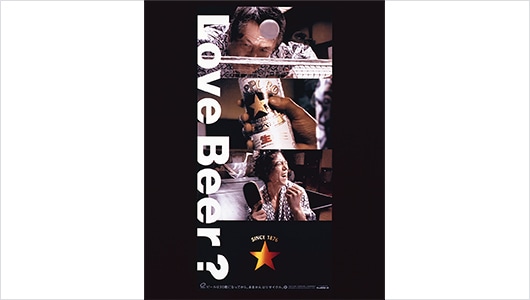
A poster for the Kuro Label Ping Pong at the Hot Springs campaign